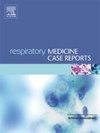Acute eosinophilic pneumonia associated with mefloquine prophylaxis: A case report
IF 0.7
Q4 RESPIRATORY SYSTEM
引用次数: 0
Abstract
Background
Eosinophilic pneumonia is a rare but potentially life-threatening condition characterized by eosinophilic infiltration of the lung parenchyma, which can present as acute respiratory failure. Drug-induced eosinophilic pneumonia (DIEP) has been associated with several medications, though the pathophysiological mechanisms remain incompletely understood. Among antimalarial agents, mefloquine has rarely been implicated in severe pulmonary adverse effects.
Case presentation
We report the case of a 34-year-old previously healthy female who developed acute respiratory failure after completing a prophylactic regimen of mefloquine for malaria prevention. The patient initially presented with fever, dyspnea, and hypoxemia, rapidly progressing to severe respiratory distress requiring invasive mechanical ventilation. Laboratory tests revealed marked eosinophilia, while thoracic computed tomography (CT) demonstrated diffuse ground-glass opacities and nodular infiltrates. Bronchoalveolar lavage (BAL) was positive for Rhinovirus, suggesting a possible interplay between drug-induced hypersensitivity and viral infection. Following corticosteroid therapy and supportive care, the patient's condition improved, with resolution of eosinophilia and radiological abnormalities.
Discussion
This case highlights the need for heightened clinical suspicion of mefloquine-induced eosinophilic pneumonia in patients presenting with unexplained respiratory symptoms following antimalarial prophylaxis. The pathogenesis may involve immune-mediated reactions and oxidative stress, potentially exacerbated by concurrent infections.
Conclusion
Mefloquine should be considered a potential cause of acute eosinophilic pneumonia, particularly in patients with recent drug exposure. Early recognition and timely management, including drug discontinuation and corticosteroid therapy, are crucial to preventing severe complications and ensuring favorable outcomes.
急性嗜酸性粒细胞性肺炎与甲氟喹预防:1例报告
嗜酸性粒细胞性肺炎是一种罕见但可能危及生命的疾病,其特征是肺实质嗜酸性粒细胞浸润,可表现为急性呼吸衰竭。药物性嗜酸性粒细胞性肺炎(DIEP)与几种药物有关,但其病理生理机制尚不完全清楚。在抗疟药物中,甲氟喹很少涉及严重的肺部不良反应。病例介绍:我们报告了一例34岁的健康女性,在完成甲氟喹预防疟疾的预防性方案后出现急性呼吸衰竭。患者最初表现为发热、呼吸困难和低氧血症,迅速发展为需要有创机械通气的严重呼吸窘迫。实验室检查显示明显的嗜酸性粒细胞增多,而胸部计算机断层扫描(CT)显示弥漫性磨玻璃混浊和结节浸润。支气管肺泡灌洗(BAL)鼻病毒阳性,提示药物致过敏与病毒感染之间可能存在相互作用。经过皮质类固醇治疗和支持性护理,患者的病情得到改善,嗜酸性粒细胞增多和影像学异常得到缓解。本病例强调,在抗疟预防后出现不明原因呼吸道症状的患者,需要加强对甲氟喹引起的嗜酸性粒细胞性肺炎的临床怀疑。发病机制可能涉及免疫介导的反应和氧化应激,并发感染可能加剧。结论甲氟喹是引起急性嗜酸性粒细胞性肺炎的潜在原因,尤其是近期有用药史的患者。早期识别和及时管理,包括停药和皮质类固醇治疗,对于预防严重并发症和确保良好结果至关重要。
本文章由计算机程序翻译,如有差异,请以英文原文为准。
求助全文
约1分钟内获得全文
求助全文
来源期刊

Respiratory Medicine Case Reports
RESPIRATORY SYSTEM-
CiteScore
2.10
自引率
0.00%
发文量
213
审稿时长
87 days
 求助内容:
求助内容: 应助结果提醒方式:
应助结果提醒方式:


